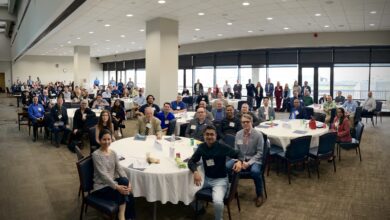
Released on 13 March, the House Science, Space & Technology Committee’s “Views and Estimates” for FY 2018 put a strong emphasis on federal support for basic research in the physical sciences, which the Committee concludes has the “greatest potential for scientific breakthroughs that will benefit new industries and U.S. jobs.”
Prepared as part of the annual federal budgeting process, the Committee’s “Views and Estimates” address more than $42 billion in federal science and technology (S&T) programs under its purview and are used by the House Budget Committee in developing the federal budget resolution by function.
The Views and Estimates note the Science Committee’s plans to complete reauthorization legislation on all the agency programs within their jurisdiction, including NASA, the National Science Foundation (NSF), the Energy Department’s Office of Energy Sciences, the National Institute of Standards and Technology (NIST), the National Oceanic and Atmospheric Administration (NOAA) and others.
Reauthorization priorities include improving accountability and oversight, reducing the administrative burden on researchers, and increased efficiency, including the elimination of duplicative research.
The Committee’s priorities for each agency follow:
NASA
- The Views and Estimates support the funding priorities outlined in the recently passed NASA Transition Authorization Act (S. 442), which calls for an FY 2017 NASA budget of $19.5 billion.
- The Views and Estimates suggest that the Budget Committee can “maintain the overall level of investment in NASA by reducing NASA Earth Science funding to $1.45 billion, reallocating “the resulting $471 million (in savings) to Planetary Science, Astrophysics, Heliophysics, the Orion Exploration Multi-purpose Crew Vehicle, the Commercial Crew Program, and Exploration R&D.”
National Science Foundation (NSF)
- The Views and Estimates require that NSF research funding be appropriated down to the Directorate level, with 70 percent of the research funding earmarked for allocation to the Mathematical and Physical Sciences Directorate, the Computer and Information Science and Engineering Directorate, the Biological Sciences Directorate, and the Engineering Directorate.
NSF and the science community have resisted congressional budgeting at the directorate level, arguing that the scientific community and peer review processes are better equipped to determine what NSF’s research priorities should be, and which research should be funded.
National Institute of Standards and Technology (NIST)
- The Views and Estimates call for an increase to the core funding in NIST metrology laboratories for generic technology transition to innovation with offsetting cuts to the NIST Industrial Technology Services account used for manufacturing and other extension programs.
- The Views and Estimates also stress the Committee’s commitment to ensuring that NIST maintains a leadership position in cybersecurity standards-setting, and for research and analysis of federal agencies’ cybersecurity readiness.
Department of Energy ” Office of Energy Sciences (OES)
- The Views and Estimates request the Budget Committee to sustain OES’s current funding levels, and calls for OES’s National Laboratories funding to be allocated by basic research program, with an emphasis on Basic Energy Sciences, Advanced Scientific Computing Research, and Fusion Energy Sciences. These priorities would be funded through offsetting reductions to the allocation for Biological and Environmental Research.
- The Views and Estimates call for a reduction of at least $750 million in budget function 270, which funds DOE’s Energy Efficiency and Renewable Energy R&D and DOE’s ARPA-E program.
- The Views and Estimates also communicate the Science Committee’s intent to reauthorize nuclear R&D activities, noting that “advanced nuclear reactor technology provides a great opportunity to make reliable, emission-free electricity available throughout the industrial and developing world.”
National Oceanic and Atmospheric Administration (NOAA)
- The Views and Estimates prioritize NOAA “public safety” weather research, the commercial weather data pilot project, and simulation and next generation computing investments to improve weather observation data forecasting.
- At the same time, the Views and Estimates note “hundreds of millions of dollars in savings are available by reducing NOAA climate change programs and big, government satellite system costs.”
Federal Aviation Administration (FAA)
- The Views and Estimates call for a rebalancing of FAA’s effort to prioritize aviation safety-related funding across the full spectrum of aviation systems, as well as adequate funding to support licensing and permitting of commercial space launch and reentry activities.
Dept. of Transportation Surface Transportation R&D
- The Views and Estimates take issue with the 2015 highway bill (P.L. 114-94), which redirected one-third in highway-related R&D to support current infrastructure implementation. The V&E notes “while not opposing technology deployment, doing so at the expense of R&D funds, without which there will be less transformational technology to deploy, is ill-advised.”
Environmental Protection Agency (EPA) S&T
- The Views and Estimates support cuts to EPA’s S&T account, noting that even reduced funding should be conditioned on EPA making publicly available all scientific and technology information and data used to support any agency risk or hazard assessment, regulation, impact assessment or guidance.
Department of Homeland Security S&T
- The Views and Estimates call for the DHS S&T Directorate to be reformed and reorganized to better support DHS threat response functions, and highlights the DHS Domestic Nuclear Detection Office as a model for combining R&D with technology acquisition and deployment to support their anti-nuclear terrorism mission.
- The Views and Estimates refers to the $2 billion in climate change research administered through multiple agencies as being “duplicative and poorly defined,” and recommends that any future funding “should only be available continent on a finding by the administration that it is not duplicative or wasteful based on a government-wide review of climate change research.”
As expected, the Science Committee’ Democrats took exception to the Republican majority’s Views and Estimates, complaining that “it is impossible to provide thoughtful consideration of the President’s fiscal year 2017 (FY17) budget request in these Views and Estimates because of the arbitrary deadline that has been imposed, requiring them to be submitted before the President’s budget request is delivered to Congress.”
In addition to expressing concerns about overall funding levels available to support R&D, the minority party Views and Estimates reiterates support for areas targeted for cuts in the majority Views and Estimates. Particular support is indicated for DOE’s ARPA-E program, climate change research, and clean energy innovation. The Democrats also call for prioritizing important areas of emerging technology to ensure continuing U.S. leadership in technology, noting in particular engineering biology, which is described as “the emerging field at the intersection of biology, the physical sciences, engineering and information technology.”
You can review the FY 2018 Views and Estimates at: https://science.house.gov/






